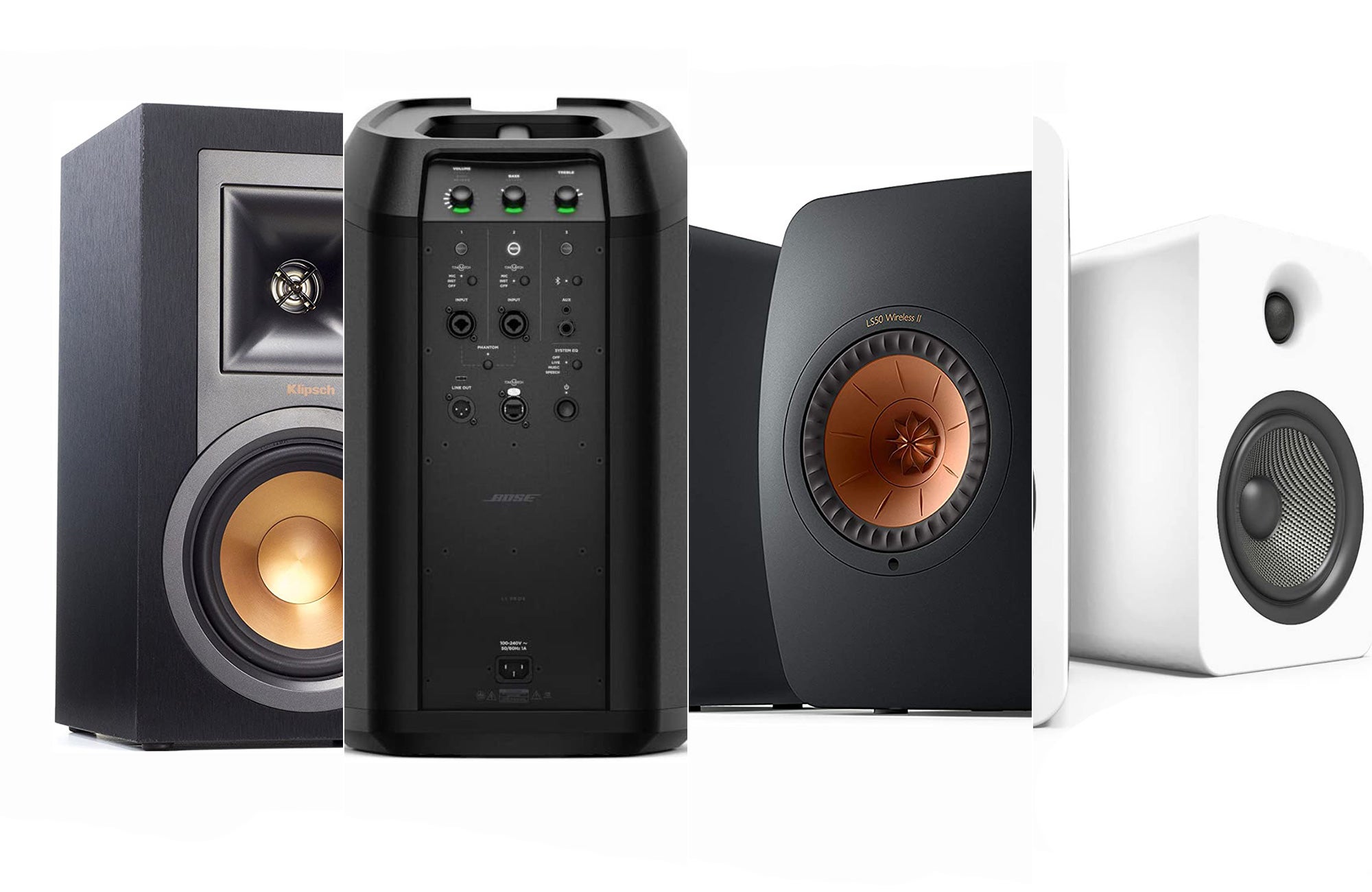The best powered speakers are a minimalist’s dream: Because they feature built-in amplification, there’s no power-matching, no racks of components, and cable clutter is essentially nonexistent: Just plug the speakers into wall power, connect your sound source, and you’re in business.
Increasingly, powered speakers are being marketed as all-in-one sound hubs, combining the convenience of built-in power with wireless connectivity and smart assistants. But powered speakers aren’t just designed to spark joy in your less-is-more living space; they often offer sonic advantages over passive models. Because amplification is built into the speaker, it’s perfectly optimized for the specific speaker driver(s) needs. Amps sit right inside the cabinet, so there’s no need to connect long lengths of wire between drivers and amplifiers, which takes cable-induced distortion and signal loss out of the picture. In addition, integrated crossover design gives the designer more control over the frequency response.
Note that not every speaker manufacturer designs its own amplifiers, sometimes relying on OEM parts. This isn’t a deal-breaker, but be sure the technologies are well implemented for the best sonic performance.
If you’re searching for a sweet new sound system, start your journey with our roundup of the best powered speakers of 2022.
- Best overall: JBL 4305P
- Best for the bookshelf: KEF LS50 Wireless II
- Best for record players: Kanto YU6
- Best powered PA speakers: Bose L1 Pro8
- Best budget powered speakers: Klipsch R-15PM
How we chose the best powered speakers
We explored hundreds of products in our pursuit of the best powered speakers: We concentrated mainly on companies with a lot of experience designing powered models and, while we considered a range of listening applications, we prioritized speakers that offer convenience and connectivity features but focus on fidelity first. Our in-house hi-fi heads and active producers debated our favorite models, solicited input from experts, and collected user impressions, performing listening tests whenever possible as we narrowed down the contenders.
Things to consider before buying powered speakers
Buying powered speakers is a personal process, weighing subjective factors like sonic preferences along with objective benchmarks like power output, number of inputs and outputs, and convenience features. Many factors influence a powered speaker’s sound, including driver and cabinet size, type of amplification, and build quality; the size of your listening space also plays a major role. Your sound sources will also inform your decision: If you’re planning to connect a turntable, for example, you’ll need phono inputs. If you want to stream music, you’ll need Bluetooth or Wi-Fi. One drawback of powered speakers is the inability to mix and match or upgrade components, such as receivers.
What size powered speakers should I get?
Powered speakers are available in a vast array of sizes, from smart speakers you can fit in the palm of your hand to towers that top 6 feet in height. In general, the bigger the speaker, the more power it can put out, and the deeper the bass it can produce. But this doesn’t necessarily mean that more is better. Speakers should be small enough to efficiently produce space-filling sound; if they’re too powerful for the size of the room, they can’t be operated at their ideal performance levels and can end up sounding boomy. On the other hand, they must be powerful enough to easily reproduce the most dynamic music, movie, and game content. Generally, bookshelf speakers with 5- or 6-inch drivers are good matches for offices, dens, and other small rooms, while larger bookshelf speakers and floorstanding models with 8-inch drivers are more appropriate for bigger rooms, like home theatres.
What kind of features should I look for in powered speakers?
Increasingly, powered speakers offer more features than their passive counterparts, evolving into all-in-one entertainment hubs for minimalists who don’t want to navigate a sea of components and cabling. If you’re in the less-is-more camp, you’ll appreciate features like digital and analog inputs and Bluetooth and Wi-Fi streaming, in addition to built-in amplification.
Should I add a subwoofer?
You should add a subwoofer if you want to extend your system’s low-end energy and bring more visceral impact to your listening experience, whether you’re watching the latest action flick, crushing your favorite videogame, or transforming the living room into a dance floor. You can mix and match speakers and subs, but many products profiled here are designed to pair perfectly with available companion subwoofers. Remember that you can always start small and add a sub later if you’re not feeling enough room-rocking thunder.
The best powered speakers: Reviews & Recommendations
As more speaker makers add powered models to their lineups, wading through the choices can get pretty overwhelming. We’ve made things a little easier with our top choices for a range of listening scenarios, from best-loved bookshelf speakers to all-in-one PA systems to power your next pool party or jam sesh. With models here starting below $200, you’re sure to land on the best powered speakers for your budget and lifestyle.
Best powered speakers overall: JBL 4305P
Why it made the cut: Advanced transducer designs, hi-res streaming, and prosumer connectivity make this powerhouse speaker well-suited for both pro monitoring and casual listening.
Specs
- Driver complement: 2 (one 1” compression driver, one 5 ¼-inch composite woofer)
- Amplification: 300 W rms
- Frequency response: 45 Hz – 25 kHz
- Dimensions: 13.2 x 8.3 x 8.8 inches (H x W x D)
Pros
- Inputs support both consumer and pro devices
- 24-bit/96 kHz converters preserve hi-res audio
- Optimize sound with room-correction EQ
Cons
- Pro sound comes with a premium price
JBL is no newcomer to powered speakers, introducing some of the first models as far back as the 1960s. The company’s brand-new 4305P compact bookshelf speaker ($2,200/pair), which debuted this past January at CES 2022, is the first powered model in its consumer Studio Monitor series. This fully loaded speaker features built-in Class D amplification, 24-bit/192 kHz converters, and six audio inputs that can connect to a huge range of digital and analog sources to provide comprehensive, hi-res wired and wireless connectivity.
The 4305P aims to deliver the punch and power of a floorstanding speaker, using patented JBL transducer technologies: each speaker features a 2410H-2 1-inch compression driver mated to a High-Definition Imaging horn for crystal-clear highs and lifelike dynamics. A 5.25-inch cast-frame, fiber-composite cone woofer operates in a bass-reflex configuration with dual front-firing tuned ports.
An onboard Class D amp delivers 25W to each compression driver and 125W to each woofer for a total system power of 300W rms. Other features include a bass contour control to compensate for acoustic issues introduced by speaker placement, and a signal-sensing line-level subwoofer out.
When it comes to high-res streaming, the 4305P takes quality to the next level, thanks to an integrated streaming engine that provides wired and wireless network audio capabilities via Ethernet, Google Chromecast Built-in, Apple AirPlay 2, and Bluetooth 5.1.
A 24-bit/192 kHz high-resolution digital-to-analog converter preserves high streaming resolution; when speakers are tethered with the included 2m Digital Link cable, resolution can be extended to 192 kHz. The 4305P can render MQA files (the musical equivalent of a ZIP file, a way to encode and distribute full-spectrum audio in a compressed container) and is Roon Ready, giving you access to a compatible music server while on your local network. As a bonus, JBL has thrown in a 90-day Qobuz trial membership that includes a curated playlist of songs that showcase the speaker’s audio capabilities.
Analog ins include combo XLR and ¼-inch TRS phono connectors and a selectable input-sensitivity switch. This configuration provides the option for balanced XLR and ¼-inch TRS (tip/ring/sleeve) or unbalanced TS (tip/sleeve) connections, which cover both pro and consumer gear. Other I/Os include asynchronous USB and optical digital inputs and a 3.5mm analog in. In addition to front-panel controls, the 4305P includes a Bluetooth handheld remote and can be controlled as part of a Google Home or Apple AirPlay ecosystem.
The 4305P’s enclosure is constructed from 3⁄4-inch MDF with internal bracing and is finished in wood veneer, styled in Natural Walnut with a blue grille or Black Walnut with a black grille. With its pedigree and presence, the 4305P can look as at home flanking a mix console as it does facing your comfiest listening chair.
Best powered bookshelf speakers: KEF LS50 Wireless II
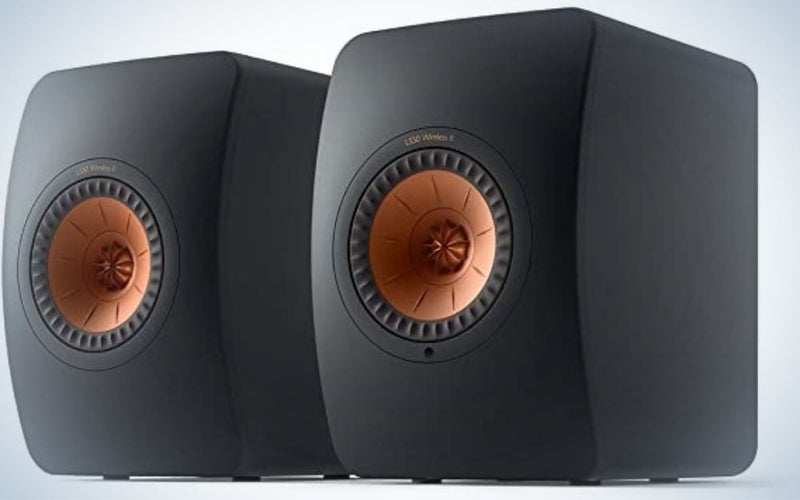
Why it made the cut: Built-in amplification, hi-res audio support, acoustic upgrades, and futureproof connectivity add up to a full-featured audiophile-grade wireless hub.
Specs
- Drivers: 2 (one 1”, one 5 ¼”)
- Amplification: 380W per speaker
- Frequency response: 45 Hz – 28 kHz
- Dimensions: 12 x 7.9 x 12.2 inches (H x W x D)
Pros
- Set up a whole-home system with Chromecast
- Robust wired and wireless connectivity
- Future-proof app tech
Cons
- Speakers and stands are very pricey
In 2016, KEF debuted the LS50 Wireless, a successor to its classic LS50 bookshelf speaker that added built-in amplification and streaming. The next-gen LS50 Wireless II boasts refinements to acoustics, connectivity, and the KEF Connect control app.
Inside each speaker, custom amps deliver 280 watts of power to each woofer and 100 watts to each tweeter for big, clean, distortion-free sound at any volume. Digital processing lets you fine-tune the sound to fit your space, either on-speaker or via the free KEF Connect app.
The LS50 Wireless II is available in signature KEF Carbon Black, Titanium Grey, Mineral White, and Crimson Red finishes, with optional matching stands. KEF’s striking, copper-hued Uni-Q driver orients a 1-inch vented aluminum-dome tweeter in the acoustic center of a 5 ¼-inch magnesium-aluminum alloy woofer cone to create a wide listening sweet spot; a bass-reflex cabinet with elliptical rear ports is designed to maximize accurate, musical low end. And Metamaterial Absorption Technology (MAT) behind the drivers takes in unwanted reflections and reduces distortion. Much like the JBL 4305P (above) is precise and dynamic, the LS50 Wireless II is spacious and punchy.
The LS50 Wireless II supports Hi-Res Audio; network file support is 24-bit/384 kHz; a wireless setup supports 24-bit/96 kHz audio resolution, or connect the speakers with the supplied CAT 6 cable for 24-bit/192 kHz support. Stream music directly over Bluetooth or Wi-Fi, AirPlay 2, and Google Chromecast, or through the KEF Connect app, which supports Spotify Connect, Tidal, Qobuz, Amazon Music, and Deezer. In addition, you can use the LS50 Wireless II as an endpoint if you set up a Roon music library on your local network. Wired connections include HDMI eARC, Ethernet, coaxial and optical inputs, a subwoofer out, and 3.5mm aux ins.
The LS50 Wireless II is pricey, typically retailing for $2,799/pair, plus $449 for optional S2 floor stands. (Willing to sacrifice some features to save some money? KEF makes a baby brother Wi-Fi connected speaker system, the LSX, or you can opt for just Bluetooth connectivity and pick up the Dynaudio Xeo 2s at $699/pair.) But if your budget supports it, The LS50 Wireless II’s versatile connectivity options make it an ideal all-in-one listening system.
Best for record players: Kanto YU6
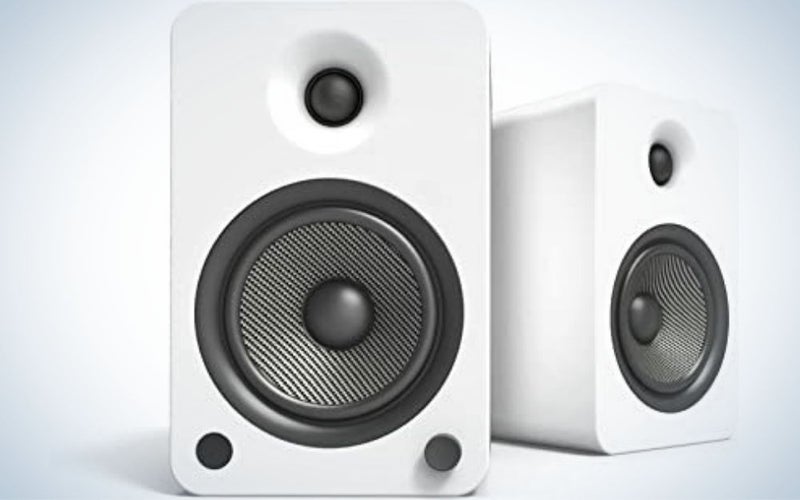
Why it made the cut: Connect all of your digital and analog gear to these stylish speakers, available in seven stunning finishes.
Specs
- Driver complement: 2 (one 1” silk-dome tweeter, one 5.25-inch Kevlar cone woofer)
- Amplification: 100W rms
- Frequency response: 50 Hz – 20 kHz
- Dimensions: 13.98 x 6.89 x 10.71 inches (H x W x D)
Pros
- Versatile inputs support turntables
- Well-balanced sound with respectable bass
- Seven gorgeous finishes elevate any décor
Cons
- USB connection is underutilized
Enjoy listening to both analog and digital sound? The Kanto YU6 ($399/pair) has you covered, with analog RCA and 3.5mm mini-jack ins, a switchable phono preamp/line-in, optical TOSLINK inputs, and Bluetooth 4.0 streaming with aptX support.
This versatile powered speaker features 1-inch silk-dome tweeters and 5.25-inch Kevlar cone woofers, powered by built-in Class D amps (50W rms per channel); it’s all housed in rear-ported fiberboard cabinets that come in a spectrum of bold finishes, including matte black, matte white, gloss black, gloss white, gloss red, bamboo, and walnut. (Available stands support a range of desktop and home theater scenarios.)
Vinyl fans will gravitate right to the YU6’s rear-panel RCA stereo input, which is switchable between moving magnet phono preamp-in and analog line-in. Optical ins connect TV, CD player, or game console digital audio. A USB jack charges devices and a subwoofer output with 200 Hz lowpass filter provides the ability to extend the low end with a standalone sub.
One note: If you’re using the YU6 speakers for a turntable playback system, it’s best to position your turntable and cabinets on separate furniture or stands or add a turntable platform to control vibration. (Just getting started on your vinyl journey? Fluance makes some great options to consider when it comes to turntables we like, such as the RT81 and RT85.)
A front-panel control knob provides simple access to volume and input adjustments: Twist the knob to adjust volume, press it to cycle through inputs. The included remote control handles power, volume, mute, EQ, source input, and Bluetooth pairing. Rubber feet are supplied but not attached.
Looking for a step up from the YU6? Kanto’s premium TUK powered speakers ($899) feature onboard DSP, high-performance AMT tweeters and 5.25-inch aluminum drivers, active crossovers, plus dedicated phono, RCA, and Optical TOSLINK inputs, onboard USB DAC and headphone amp, and Bluetooth 4.2 with aptX HD and AAC codecs.
Best powered PA speakers: Bose L1 Pro8
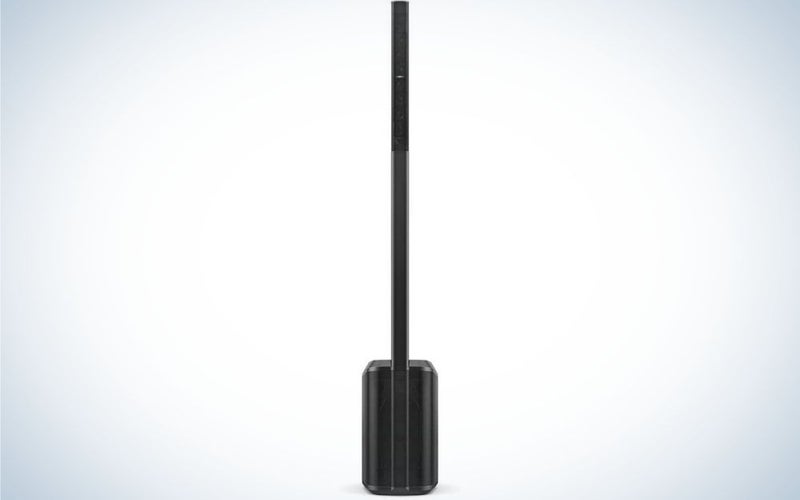
Why it made the cut: This all-in-one sound system packs up tight to go from vehicle to venue in a single trip.
Specs
- Driver complement: 8 2” neodymium drivers, 1 7×13” subwoofer
- Amplification: 60W (driver array), 280W (subwoofer)
- Frequency response: 45 Hz – 16 kHz
- Dimensions: 78.94 x 17.32 x 38.92 inches (H x W x D) assembled
Pros
- Eight-speaker array provides broad coverage
- Control mixes from your mobile device
- Two phantom power inputs
Cons
- Assembled system can feel unstable in windy conditions
Whether you’re a singer/songwriter, band, DJ, or just looking for a plug-and-play-simple way to transform your next BBQ into an impromptu dance party, a portable powered public address system is the perfect all-in-one sound solution. Powered PA systems are serious multitaskers, delivering pro-quality sound reinforcement with built-in amps, mixers, audio effects, Bluetooth streaming, and tons of I/Os, in self-contained systems you can schlep in one hand while you carry your guitar (or beer) in the other.
Nearly 20 years ago, Bose introduced the shockingly portable L1 PA, which became a go-to gig staple for indie artists thanks to its premium sound and built-in amplification, mixer, effects, and subwoofer. The series has been updated over the years and the L1 Pro line debuted in 2021, in driver configurations up to 32 speakers.
The L1 Pro8 ($1,199), the most portable array in the Pro series, is ideal for singer/songwriters and mobile DJs. Inside, a C-shape 8-driver array that provides 40 degrees of vertical coverage and 180 degrees of horizontal coverage, with an integrated subwoofer that features an elongated RaceTrack driver, which Bose says delivers low-end performance that rivals a conventional 12-inch woofer in a slimmer footprint. All L1 Pro models feature a built-in 3-channel mixer: Channels 1 and 2 can receive signal from combo XLR/TRS jacks (with phantom power), while Channel 3 can receive signal from either a 1/8-inch headphone jack, a ¼-inch TRS jack, or via Bluetooth streaming.
This system sets up fast, is easy to operate, and packs a sonic punch, powering the speaker array with 60 watts of Class D amplification and the subwoofer with 240 watts, for 118 dB peak SPL.
Use the Bose L1 Mix App to adjust mixes and effects settings (including Bose’s ToneMatch library of custom EQ presets) from anywhere in the room. The system weighs just 35 pounds and disassembles into three pieces that pack into the base unit for effortless transport in the included travel bag.
Thinking of cutting the cord entirely? Check out Bose’s S1 Pro portable Bluetooth speaker, which has three 2 1/4-inch high-frequency drivers and a 6-inch low-frequency woofer and provides up to 11 hours of play time. Or keep all the features (and, admittedly, the price) and get the rechargeable 1,500W JBL EON ONE MK2 column PA, with 8 2-inch tweeters, built-in 10-inch woofer, and a 5-channel mixer that can run off a 6-hour battery.
Best budget: Klipsch R-15PM
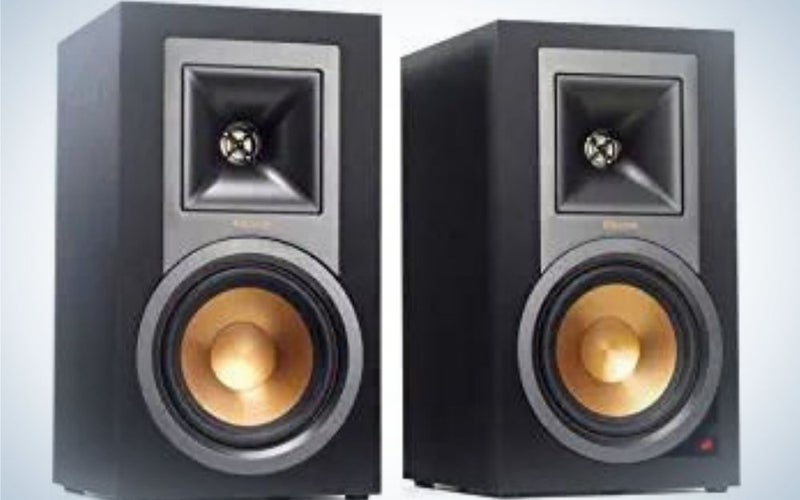
Why it made the cut: When it comes to price/performance ratio, these feature-packed budget beauties punch way above their class.This all-in-one sound system packs up tight to go from vehicle to venue in a single trip.
Specs
- Driver complement: 2 (one 1”, one 5 ¼”)
- Power rating: 50 WPC
- Frequency response: 62 Hz – 24 kHz
- Dimensions: 12.5 x 7 x 8.11 in (H x W x D)
Pros
- Diverse I/O set handles a range of sound sources
- Onboard phono amp
- Convenient remote
Cons
- Difficult to conceal cables when using stands
Klipsch R-15PM powered bookshelf speakers boast 50 watts per channel of amplification, for room-filling sound in a super-compact footprint. Each speaker features a 1-inch aluminum diaphragm compression driver that’s integrated with Klipsch’s square Tractrix horn, which Klipsch says delivers wider dispersion and cleaner, clearer highs; a distinctive, 5-¼-inch spun copper woofer provides solid midrange, and a rear-firing port beefs up bass response. It’s all housed in resonance-deadening MDF cabinets for smooth, distortion-free response.
These speakers, which retail for an affordable $275/pair, offer an incredible array of features on top of their solid sound performance. Setup is plug-and-play easy: Connect directly to a range of sound sources, from your tablet to your TV, thanks to an onboard phono preamp, Bluetooth connectivity, and a range of analog and optical digital inputs, plus a USB Type B input. A remote lets you adjust volume and change inputs from the convenience of your couch. A mono subwoofer output connects an optional powered sub; consider Klipsch’s wireless Reference R-10SWi.
For an alternative at the same price point, check out the Audioengine A2+ wireless Bluetooth bookshelf speakers, or if you’re hoping to keep your purchase below $200, the Edifier R1700BT, at $159, is a worthy contender.
FAQs
Q: What’s the difference between passive speakers and powered?
Powered, or active, speakers have built-in amplification, while passive speakers need to be powered by an external amplifier, such as a stereo receiver or integrated power amp. Powered speaker setups are pretty turnkey, requiring fewer components and annoying cables—but more importantly, your speakers are already perfectly matched to the right amplifier. Passive speakers are often preferred by audiophiles because they offer the flexibility of mixing and matching components, for more control over system sound. And, unlike powered speakers, passive speakers don’t have to plug into a power outlet, which provides more placement options in some spaces.
Q: Do powered speakers sound better?
Powered speakers, by design, offer some sonic benefits: By incorporating precisely matched drivers, amps and crossovers, they can deliver cohesive sound that’s harder to achieve with discrete components. And, you never have to worry about underpowering or overpowering your speakers—no matter how loud you crank it up.
Traditionally, passive speakers have been sought out by hi-fi fans, because they provide opportunities to swap out and upgrade components. But these days, you’ll find a vast range of great-sounding options in both passive and powered categories.
Q: Can I connect powered speakers to an amplifier?
Not unless you want to blow up your gear. Technically, it’s possible to connect powered speakers to an amplifier, and there are some niche cases where it might make sense, such as using speakers with bypassable built-in amplification. But really, we don’t recommend it. There’s a reason why the Golden Rule of Sound is: “Power + Power=Disaster”!
Final thoughts on choosing the best powered speakers
If you strive for a simple, minimalist setup, and don’t want to deal with connecting racks of audio components and yards of cables, powered speakers just might be perfect for you. Anytime you’re shopping for speakers, fidelity comes first. That said, we’ve spotlighted versatile products that excel in a range of scenarios. If you choose any of the speakers here, you won’t be disappointed.
